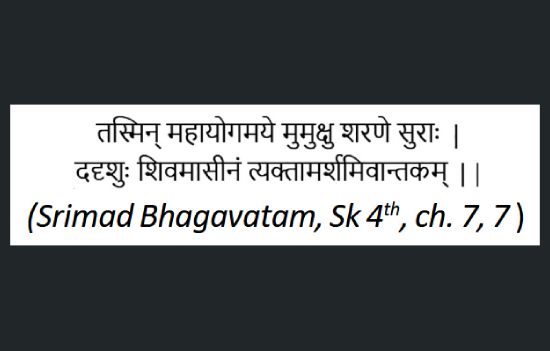- Know
about Dakshina Murty.
Bhagavan Shiva is generally depicted as a destructive power of the Trinity,
while Brahma creates, and Vishnu protects the Universe. Similarly, Shiva is
worshipped in a symbolic form as the shivalingam. Shiva shrines are the oldest
in our land.
However, there is a tradition of worshipping him as a benefactor and Guru.
This form is Sri Dakshinamurty, with several images installed in Shiva temples mostly
in Southern India. Some scholars identify the Yogishvara image in Ellora with
this form of Shiva.
This article was
first published in the Bharatiya Vidya
Bhavan Journal.
There are images of Dakshinamurty in many temples, more in South India than
elsewhere. He has four arms, two holding Akshamala
and Pustakam, and snakes in the other
two. A stotra attributed to Adi Shankaracharya describes him as:

It is indeed surprising to see that while the disciples assembled under the
banyan tree are elderly, the teacher is young and his way of teaching is
silence, clearing all doubts of disciples.
Another interesting anecdote of Lord Shiva, in meditation under Yogavata vriksham is described in the 4th
skanda of Srimad Bhagavatam: (Srimad Bhagavatam, Sk 4th, ch. 7, 7 )

After destroying Daksha Yajnam, Rishis saw Lord Shiva, sitting under Yogavata
Vriksha, like the Lord of Death, as if he were relaxing after dissolution.
Several prominent Maharishis gathered there to listen to his exposition of
sacred lore.
However, Puranic stories connected to Bhagavan Shiva have no reference to
his avatar as a Guru, since he is destructive in nature (of all evil forces).
Teaching in silence however, is an attribute of Lord Buddha, who is termed as avachanam Buddhavachansam’, which means the word of Buddha is silence. Of course, his disciples were much older than him while he was a young man.
There is an earlier commentary on Dakshina Murty Stotram by Adi Shankaracharya’s direct disciple Sri Sureshvaracharya himself, who headed his Pitha at Sringeri, Karnataka after Shankaracharya. His commentary refers more to tenets of Advaita Vedanta, than this form of Shiva.
There are many temples dedicated to Lord Shiva in south and north India.
However, the image of Shiva as Dakshina Murty is worshipped only in the South, while
there is a shivalingam named Dakshina Murty at the famous
shrine of Mahakaleshvar, Ujjain. Dakshina Murty appears in more than
form and posture. At some places, he sports a Veena, has Parvati by his side,
or reclines like Anantashayana, a form of Vishnu.
According to researchers, there are several variables in the forms of Dakshina
Murty, like Dharma Vyakhyana Murty, Veenadhara Murty, Jnana Murty, Yoga Murty, Kamadahana Murty, based on episodes from
Shaiva lore and Purana texts. In all such forms the Lord is seen seated under
the Banyan tree (Yoga Vatavriksha).
Dakshina Murty means God of
Wisdom, clarity, and blessing devotees with knowledge of scriptures.
Dakshina Murty images are traced as early as 650 CE, some images called aalamarachelvan and takkinan in Tamil land, during the Sangam era. However, such images
on Rajagopurams are a little recent, as late as 300 to 400 years ago, like
those on the main tower of Meenakshi temple, Madurai. They can be seen commonly
in constructions in later Chola and Pandian rulers in the South.
In most of the above forms the Lord is seated in Virasana, Maharajalilasana,
in a grand manner with or without attendants. Interesting enough, an image of ardhanari form—with the left part portrayed as Parvati, his consort and right, Dakshina Murty himself. A host of Rishis, his attendants like Virabhadra, 9 rishis on either side along with Agastya. Perhaps, only one such image exists according to studies.
Dakshina Murty is placed at a separate corner of Shiva shrines, keeping his
right feet above left, crushing a demon Apasmaara, under him. Normally devotees get their kids’ initiation to learning Alphabets (aksharabhyasam) here, and also pray for
removal of Gurugraha Dosham in their horoscope
on advice of astrologers.
Normally, he appears in meditative pose, teaching many rishis, some closing
their palms in reverence to a Guru (Anjali
bandha). In all such structures of a Dhyana
Murty, we see Shiva holding torches in the upper hands, and a Japa Mala and
books in the lower hands, with four hands in all. Regular features of Shiva
with Damaru, Shoola, Pasha and snake around
neck are absent. He is in an ideal state of a meditative yogi.
However, Dakshina Murty is eulogised in a few stotras, Kalpas, with a Dakshinamurty Upanishad in his name,
teaching Advaita Vedanta. His leelas find place in Sangam period’s literature in Tamil. He is popular as the Lord of wisdom in several places of worship in Kerala, Andhra Pradesh and Karnataka, and in several Shiva shrines.
This article was first published in the Bhavan’s Journal, November 1-15, 2025 issue. This article is courtesy and copyright Bhavan’s Journal, Bharatiya Vidya Bhavan, Mumbai-400007. eSamskriti has obtained permission from Bhavan’s Journal to share. Do subscribe to the Bhavan’s Journal – it is very good.